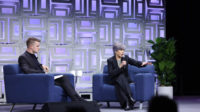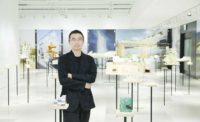It was a kitchen caper enough to give most people nightmares. A woman in her mid-70s, who recently suffered vision loss, would enter her kitchen and each time emerge with black-and-blue marks. Diminished eyesight had stolen her ability to discern contrast between cabinets and the surrounding wall surfaces, explains Michael Honan, a clinical rehabilitation manager at Lighthouse International. In the glare of two bright windows, she continually bumped into doors that she was unable to see.
With the aging of the baby boom generation, this senior’s experience may soon be commonplace. Tara Cortes, president and CEO of Lighthouse, a vision services agency, points to several figures that suggest the U.S. is on the verge of a low-vision epidemic: Six million Americans are already affected with age-related macular degeneration, the primary cause of vision loss in the U.S, and as many as 15 million more are pre-symptomatic. In addition to age-related sight loss, 5.3 million adults suffer impaired vision caused by diabetic retinopathy—approximately one quarter of diagnosed diabetics—and the obesity epidemic promises to boost that showing.
Low vision, coupled with boomers’ propensity toward independent living, suggests a different set of easy design solutions from complete blindness, which affects only 8 percent of all visually impaired people. For now, the challenge is educating architects and planners about how the approaches differ—and ending a bias to design solely for blindness.
Danise Levine, assistant director of the IDEA Center at University at Buffalo, says that while universal design principles take low vision into account, existing standards are prejudiced against low-vision building occupants. “Most accessibility codes are geared toward people with mobility issues, which is not what most low-vision people grapple with,” she explains. In cities such as Atlanta, residential “visitability” regulations, which guarantee entry and bathroom access for disabled visitors in new homes, also emphasize physical impairment. Even the best intentions, including mandatory curb cuts for wheelchair access, put low-vision pedestrians at a disadvantage, since these people are unable to discern the dip in a sidewalk’s surface.
Architects are slowly waking up to the low-vision epidemic. According to Eunice Noell-Waggoner, president of the Center of Design for an Aging Society, they are “becoming more curious” about accommodating low-vision users. The American Institute of Architects now includes information about lighting techniques in its guidelines for healthcare facilities.
Remedies are easily at hand. Simple choices about materials, lighting direction, and color contrasts can ease low-vision users’ assimilation to new construction. And an array of affordable modification devices, from talking calculators to non-glare light bulbs, allow homeowners and office workers to confidently maneuver daily life in existing spaces. Sustainability is also conducive to the phenomenon, since visual impairment-friendly task lighting usually gobbles less energy than an all-out wash, the glare from which diminishes the ability to perceive contrast.
Further, systematic efforts to improve environmental conditions for the visually impaired are underway. Leslie Moldow, AIA, a principal at Perkins Eastman who specializes in design for aging, points out that in healthcare development, better, non-glare illumination standards are being adopted one state at a time. The Center of Design for an Aging Society recently published a booklet about lighting for low vision. And Cortes reports that Lighthouse International is lobbying Congress to approve reimbursement of vision modification devices currently not covered by Medicare.
Honan, the Lighthouse clinical rehabilitation manager at who encountered the elderly bruise victim, helped improve her situation swiftly. Applying a border of electrical tape created contrast on her kitchen cabinets, and darker curtains reduced solar glare. Although solutions for low-vision environments are within reach, Noell-Waggoner says that awareness and education still has a way to go. Contractors, eye doctors, and architects all need to see the light.





Post a comment to this article
Report Abusive Comment